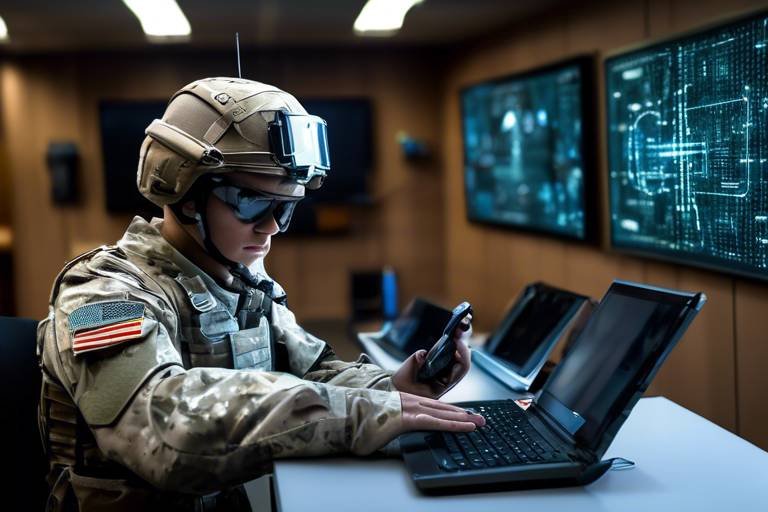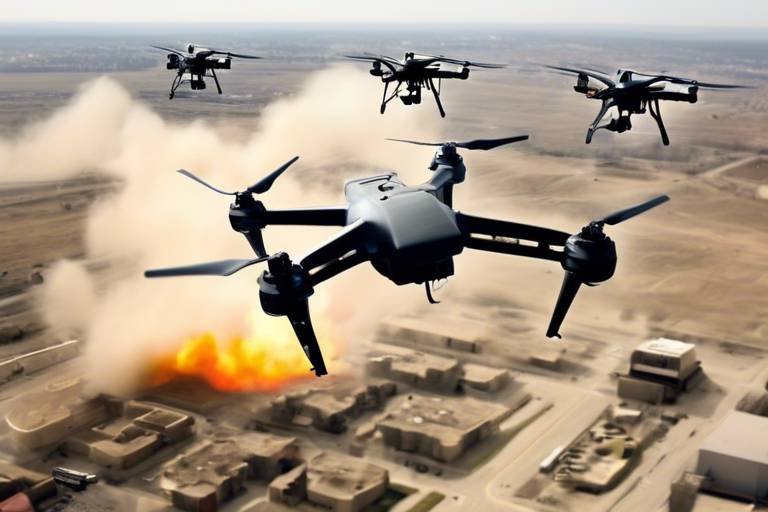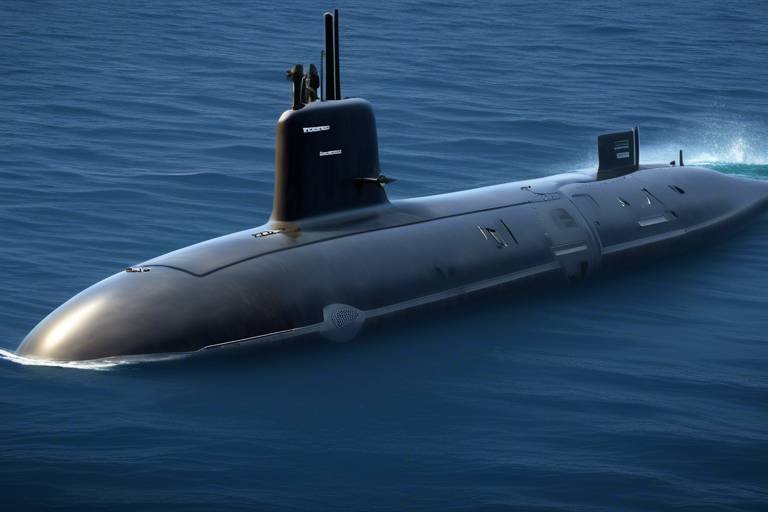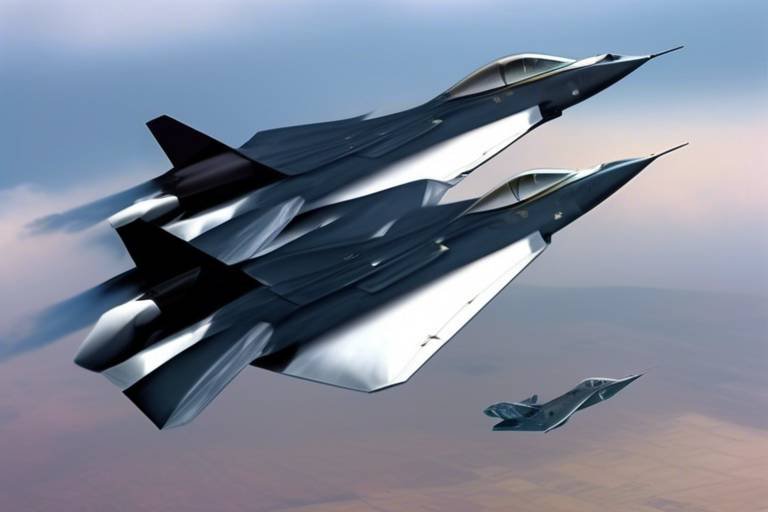The Future of Military Space Operations
The landscape of military operations is undergoing a **profound transformation**, particularly with the advent of new technologies and the increasing recognition of space as a critical operational domain. As nations around the globe invest heavily in their military space capabilities, the implications for **global security** and **defense strategies** are immense. This article delves into the rapidly evolving realm of military space operations, highlighting the **technological advancements**, **strategic implications**, and the **challenges** that lie ahead.
Innovations in satellite technology, propulsion systems, and artificial intelligence are revolutionizing the way military operations are conducted in space. For instance, the development of **miniaturized satellites** is allowing armed forces to deploy more assets at a lower cost, enhancing their **situational awareness**. With advanced propulsion systems, military satellites can now maneuver more effectively, ensuring they remain operational even in hostile environments. Moreover, artificial intelligence is playing a pivotal role in data analysis, enabling real-time decision-making that is crucial for success in military operations.
As nations prioritize space in their defense strategies, the **implications for global power dynamics** are profound. The race for supremacy in space could potentially reshape alliances and rivalries on Earth. Countries are increasingly recognizing that control of space assets equates to power on the ground. This recognition is prompting nations to reassess their military doctrines and invest in capabilities that ensure their interests are protected beyond our planet.
The acknowledgment of space as a distinct domain for warfare necessitates the development of new **doctrines** and **tactics**. Just as land, sea, and air have their unique combat strategies, space warfare requires a tailored approach. Militaries are now focusing on developing capabilities specifically designed for combat in the cosmos, which includes everything from **satellite defense systems** to offensive measures aimed at disrupting adversaries' space assets.
Countries are investing heavily in **counter-space technologies** to disrupt or destroy enemy satellites. This arms race raises significant concerns about the potential for conflict escalation. As nations build these capabilities, the need for new arms control measures becomes critical. The question arises: how can we prevent a space arms race from spiraling out of control? The answer lies in international cooperation and the establishment of **treaties** that govern military activities in space.
Developing robust defensive systems to protect satellites and space assets is vital. The vulnerabilities present in space can have cascading effects on ground-based military operations and national security. A single compromised satellite could lead to a **domino effect**, crippling communication and navigation systems that are essential for military operations. Therefore, investing in **defensive technologies** is not just an option; it is a necessity for maintaining operational integrity.
The legal framework governing military activities in space is evolving. Nations are increasingly negotiating treaties to prevent conflict and ensure the peaceful use of outer space. The challenge lies in balancing national security interests with the need for international cooperation. As military operations in space grow more complex, the establishment of clear regulations will be essential to avoid misunderstandings and potential conflicts.
Despite the advancements, operational challenges such as **space debris**, **technological limitations**, and the need for international cooperation pose significant hurdles for effective military space operations. The increasing amount of debris in orbit threatens operational satellites and poses risks to military missions, necessitating innovative solutions for debris tracking and removal.
The issue of space debris is becoming increasingly pressing. As more satellites are launched, the risk of collisions grows. This debris not only threatens operational satellites but also poses risks to future missions. Innovative solutions for debris tracking and removal are critical for ensuring the long-term sustainability of military operations in space.
Successful military space operations often require collaboration among allied nations. Joint exercises and shared intelligence can enhance collective capabilities and ensure that nations are prepared for any potential conflict in space. The importance of **international partnerships** cannot be overstated in this new era of military operations.
- What are the main technological advancements in military space operations?
Technological advancements include innovations in satellite technology, propulsion systems, and artificial intelligence, all of which enhance operational capabilities. - Why is space considered a new warfighting domain?
Space is recognized as a new warfighting domain due to the strategic importance of space assets in modern warfare and the potential for direct conflict in this realm. - What challenges do military operations in space face?
Challenges include space debris, technological limitations, and the need for international cooperation to manage risks and ensure safety.

Technological Advancements in Space
The realm of military operations in space is undergoing a remarkable transformation, driven by cutting-edge technological advancements. Innovations in satellite technology, propulsion systems, and artificial intelligence are not just enhancing military capabilities; they are redefining the very nature of warfare beyond our planet. Imagine a world where military forces can monitor global activities with unprecedented precision, thanks to advanced satellite systems that provide real-time data and analytics. This is not science fiction; it’s the current trajectory of military space operations.
One of the most significant advancements is in satellite technology. Modern satellites are equipped with enhanced sensors and communication capabilities that allow for better situational awareness. These satellites can detect threats and relay information back to command centers almost instantaneously. For instance, the integration of high-resolution imaging and multi-spectral sensors enables militaries to gather intelligence that was once only a dream.
In addition to satellites, propulsion systems are evolving at a rapid pace. The development of ion propulsion and nuclear thermal propulsion systems is paving the way for faster and more efficient travel in space. This means that military assets can be repositioned more quickly than ever, allowing for a swift response to emerging threats. Think of it like upgrading from a bicycle to a sports car; the speed and efficiency make all the difference in critical situations.
Moreover, artificial intelligence (AI) is playing a pivotal role in enhancing military capabilities in space. AI algorithms can process vast amounts of data from various sources, making it possible to identify patterns and predict potential threats. This capability not only improves decision-making but also allows for autonomous operations. For instance, drones equipped with AI can conduct surveillance missions without direct human intervention, freeing up personnel for other essential tasks.
However, with these advancements come new challenges. The increased reliance on technology raises concerns about cybersecurity and the potential for adversaries to disrupt military operations. As militaries become more dependent on sophisticated systems, protecting these assets from cyber threats becomes paramount. This is akin to fortifying a castle; the stronger the defenses, the less likely it is to fall to an invader.
In summary, the technological advancements in space are not just enhancements; they are game-changers. The integration of advanced satellite systems, innovative propulsion technologies, and artificial intelligence is transforming military operations, providing forces with the tools they need to operate effectively in the final frontier. As we look to the future, it’s clear that the sky is no longer the limit; it’s just the beginning.
- What are the main technological advancements in military space operations?
The main advancements include improved satellite technology, advanced propulsion systems, and the integration of artificial intelligence for enhanced situational awareness and operational efficiency.
- How does artificial intelligence impact military operations in space?
AI enhances decision-making by processing large amounts of data quickly and accurately, enabling autonomous operations and improved threat detection.
- What are the challenges associated with these technological advancements?
Challenges include cybersecurity threats, the potential for technology to be disrupted by adversaries, and the need for robust defensive measures to protect space assets.

Strategic Implications of Space Operations
The emergence of space as a critical arena for military operations is reshaping the geopolitical landscape in ways we are only beginning to understand. As nations around the globe prioritize their defense strategies to include space, the implications for global power dynamics are profound. It’s not just about who can launch the most satellites; it’s about who can leverage these assets to gain a strategic advantage over their rivals. Imagine the chessboard of international relations being expanded to include not just land and sea, but the vast expanse of the cosmos. The stakes are higher than ever, and every move counts.
In this new era, space is not merely a backdrop for military operations; it is becoming a critical battlefield. Countries are investing heavily in developing capabilities that allow them to operate effectively in this domain. This shift necessitates a reevaluation of existing military doctrines and tactics. As we look to the future, we must ask ourselves: what does it mean to fight in space? The answer lies in understanding that space operations will require unique strategies that are distinct from traditional land or naval warfare.
One of the most significant aspects of these strategic implications is the potential for reshaping alliances and rivalries. As nations enhance their military capabilities in space, we are likely to see new coalitions forming. For instance, countries with advanced space technologies may choose to band together, creating a powerful bloc that could influence global security policies. Conversely, nations that lag in space capabilities might find themselves isolated or at a disadvantage, sparking tensions and competition. This evolving landscape could lead to a new kind of arms race, not just in terms of technology, but in terms of influence and control over space assets.
Furthermore, the recognition of space as a warfighting domain raises critical questions about international norms and regulations. As militaries develop counter-space capabilities designed to disrupt or destroy enemy satellites, the risk of conflict escalation increases. This situation makes it essential for nations to engage in dialogue and establish treaties that govern military activities in space. Without clear regulations, the potential for misunderstandings and unintended confrontations could spiral out of control, leading to a chaotic and dangerous environment.
As we navigate these strategic implications, it’s important to consider the defensive strategies that will be necessary to protect space assets. Just as nations fortify their borders on Earth, they must also develop robust systems to safeguard their satellites and other space infrastructure. Vulnerabilities in space can have cascading effects on ground-based military operations and national security. Therefore, investing in defensive technologies and fostering international cooperation will be crucial in maintaining stability in this new frontier.
In summary, the strategic implications of military operations in space are vast and complex. As nations recognize space as a vital component of their defense strategies, the potential for shifting alliances, evolving doctrines, and the need for new regulations will shape the future of global security. The question remains: how will countries adapt to this new reality, and what measures will they take to ensure peace and stability in the cosmos?
- What are the main strategic implications of military space operations?
Military space operations can reshape alliances, create new rivalries, and necessitate the development of unique strategies and regulations. - How does space influence global power dynamics?
Countries with advanced space capabilities can gain significant strategic advantages, potentially altering the balance of power. - What are counter-space capabilities?
Counter-space capabilities refer to technologies and tactics designed to disrupt or destroy enemy satellites and space assets. - Why is international cooperation important in military space operations?
Collaboration among nations can enhance security, prevent misunderstandings, and establish norms for responsible behavior in space.

Space as a Warfighting Domain
In recent years, the notion of has gained significant traction among military strategists and defense analysts. Gone are the days when space was merely a backdrop for terrestrial conflicts; today, it is recognized as a critical arena where nations can assert their power and influence. Just as the oceans and skies were once the primary theaters of war, space is now emerging as a vital frontier in modern military operations. This shift necessitates a complete rethinking of military doctrines, strategies, and technologies.
The implications of treating space as a battlefield are profound. For instance, nations are now developing specialized capabilities designed for combat in the cosmos. This includes everything from advanced satellite systems capable of offensive and defensive operations, to ground-based missile systems that can target enemy satellites. The competition is fierce as countries strive to establish dominance in this new domain, leading to an arms race that mirrors those we have seen in the past on land and sea.
Moreover, the emergence of space as a warfighting domain raises critical questions about national security and global stability. As military operations in space become more commonplace, the potential for misunderstandings and conflicts increases. Just imagine a scenario where a satellite is taken out during a military operation—what would that mean for the country that relies on that satellite for communication and navigation? The stakes are incredibly high.
To illustrate the seriousness of this situation, let’s consider some key factors that define space as a warfighting domain:
- Technological Advancements: The development of anti-satellite weapons and advanced surveillance systems signifies a shift in how nations engage with space.
- Strategic Importance: Space assets are integral to military operations on Earth, providing critical data for intelligence, reconnaissance, and communication.
- New Military Doctrines: Armed forces are now crafting strategies specifically for space operations, reflecting its importance in modern warfare.
As we delve deeper into this evolving landscape, it becomes clear that the military must adapt to the unique challenges and opportunities that space presents. The current focus on space as a warfighting domain is not just a trend; it is a fundamental shift in how we understand warfare itself. Just like the introduction of air power revolutionized military strategy in the early 20th century, the ability to operate in space will redefine the future of conflict.
In conclusion, the recognition of space as a warfighting domain is a game-changer. It demands new technologies, innovative tactics, and a collaborative approach among nations to ensure that this domain remains a place of peace rather than conflict. The question is, are we ready for the challenges that lie ahead?
- What does it mean for space to be a warfighting domain?
It means that space is recognized as a critical area for military operations, similar to land, air, and sea, where nations can engage in conflict. - What are the implications of military operations in space?
Military operations in space can lead to increased tensions between nations, potential conflicts, and the need for new treaties and regulations to prevent escalation. - How are countries preparing for space warfare?
Countries are investing in advanced technologies such as anti-satellite weapons, surveillance systems, and developing new military doctrines tailored for space operations.

Counter-Space Capabilities
The race to dominate space is not just about launching satellites and exploring distant planets; it involves a complex web of that nations are developing to protect their interests and deter adversaries. As military operations extend into the cosmos, the ability to disrupt or neutralize an opponent's space assets has become a critical component of national defense strategies. This evolution is akin to the arms race of the 20th century, but now, the battleground is not just terrestrial but also celestial.
Countries around the globe are investing heavily in technologies that can target enemy satellites, which can include methods such as kinetic anti-satellite (ASAT) weapons, electronic warfare systems, and cyber capabilities. The landscape of counter-space operations is diverse, and each method has its own set of implications for global security. For instance, kinetic ASAT weapons, designed to physically destroy satellites, can create a significant amount of space debris, posing risks not only to military operations but also to civilian satellites and the International Space Station (ISS).
Moreover, the development of electronic warfare capabilities allows nations to jam or spoof satellite signals, effectively rendering them useless without the need for physical destruction. This method is less likely to escalate into a broader conflict, but it raises questions about the long-term sustainability of space operations. Imagine trying to navigate through a storm without a compass—this is the reality for militaries that rely on satellite data for communication, navigation, and reconnaissance.
As countries enhance their counter-space capabilities, the potential for conflict escalation increases. The United States, Russia, and China are at the forefront of this arms race, each striving to outpace the others in technological advancements. This competition can lead to a precarious situation where misunderstandings or miscalculations could trigger a conflict that spills over from the terrestrial realm into space.
To mitigate these risks, there is a growing need for international arms control measures that specifically address counter-space technologies. Treaties and agreements aimed at limiting the development and deployment of such capabilities could help establish norms and reduce tensions. However, achieving consensus among nations with differing interests and security concerns is a daunting challenge.
In conclusion, counter-space capabilities represent a double-edged sword in the realm of military operations. While they provide nations with the means to protect their space assets and deter adversaries, they also introduce new risks and challenges that could destabilize the delicate balance of power not just on Earth, but in the vast expanse of space as well. As we look to the future, the question remains: how can we navigate this complex landscape while ensuring the peaceful use of outer space?
- What are counter-space capabilities?
Counter-space capabilities refer to the technologies and strategies that nations develop to disrupt or destroy enemy satellites and other space assets.
- Why are counter-space capabilities important?
They are crucial for national defense as they help protect a country's space assets from adversaries, ensuring operational superiority in military operations.
- What are the risks associated with counter-space operations?
Counter-space operations can lead to increased tensions between nations, potential conflict escalation, and the creation of dangerous space debris that threatens all space operations.
- How can international cooperation help mitigate risks?
International cooperation through treaties and agreements can help establish norms for the responsible use of counter-space capabilities, reducing the likelihood of conflict.

Defensive Strategies in Space
As we venture deeper into the cosmos, the need for effective defensive strategies in space becomes increasingly critical. Just as a fortress needs strong walls to protect its inhabitants, our satellites and space assets require robust defenses to ensure their safety against potential threats. The vulnerabilities of these assets can have cascading effects on ground-based military operations and national security. Imagine a world where a single satellite malfunction could disrupt communication, navigation, and surveillance systems, leading to chaos on Earth. That's why developing comprehensive defensive measures is not just a priority; it's a necessity.
One of the primary defensive strategies involves enhanced satellite shielding. This can include physical barriers, such as advanced materials designed to withstand impacts from space debris or hostile projectiles. Additionally, employing active defense systems that can detect and neutralize threats before they reach their targets is gaining traction. These systems could operate similarly to missile defense systems, but in a three-dimensional space environment, where the stakes are higher and the challenges more complex.
Moreover, redundancy plays a crucial role in safeguarding space operations. By deploying multiple satellites with overlapping functionalities, military forces can ensure that if one satellite is compromised, others can take over its functions. This concept is akin to having a backup generator for your home; when the power goes out, you want to be prepared and maintain essential operations. In the realm of space, redundancy can be a game-changer, providing resilience against unexpected disruptions.
Another key aspect of defensive strategies is cybersecurity. As military operations in space become increasingly reliant on digital systems, the risk of cyberattacks grows. Protecting satellite networks from hacking attempts and ensuring secure communication channels is paramount. This is similar to securing your online banking information; the more layers of protection you have, the less vulnerable you are to potential breaches. Military organizations are investing heavily in cybersecurity measures to fortify their space assets against these digital threats.
Furthermore, international cooperation is essential for effective defense in space. Countries must work together to establish norms and protocols for space operations, sharing intelligence and resources to enhance collective security. Just like countries collaborate on global threats such as terrorism or climate change, a united front in space can deter potential aggressors and promote stability. Initiatives like joint exercises and shared satellite data can bolster defense capabilities and foster trust among nations.
In conclusion, the landscape of military operations in space is evolving rapidly, and so too must our defensive strategies. By investing in advanced technologies, enhancing redundancy, prioritizing cybersecurity, and fostering international collaboration, we can create a more secure environment for our space assets. The future of military space operations depends on our ability to adapt and innovate, ensuring that we are prepared for any challenges that may arise beyond our planet.
- What are the main threats to military satellites? Military satellites face threats from space debris, cyberattacks, and potential anti-satellite weapons developed by adversarial nations.
- How can international cooperation improve space security? By sharing intelligence, resources, and establishing common protocols, nations can enhance their defensive capabilities and deter potential aggressors.
- What role does redundancy play in satellite defense? Redundancy ensures that if one satellite fails or is compromised, others can continue to perform critical functions, maintaining operational integrity.
- Why is cybersecurity important for military space operations? As military operations become more reliant on digital systems, protecting these systems from cyberattacks is crucial for maintaining communication and operational effectiveness.

International Treaties and Regulations
The legal framework governing military activities in space is not just a collection of guidelines; it is a dynamic and evolving structure that reflects the changing nature of global security. As nations increasingly recognize the strategic importance of space, there is a pressing need for international treaties and regulations to manage these activities effectively. The Outer Space Treaty of 1967, for instance, established fundamental principles for the peaceful use of outer space, yet it is often criticized for being outdated in the face of modern technological advancements and military ambitions.
One of the primary challenges in creating effective treaties is the diverse interests of nations. While some countries advocate for the peaceful use of space, others are rapidly developing military capabilities that could lead to conflict. This dichotomy raises critical questions: How can nations agree on regulations that ensure security while allowing for technological advancement? What mechanisms can be put in place to verify compliance? These questions are becoming increasingly relevant as countries like the United States, Russia, and China invest heavily in their space programs.
To address these challenges, several initiatives have emerged. For example, the United Nations Office for Outer Space Affairs (UNOOSA) has been working to promote international cooperation in the peaceful use of outer space. Additionally, discussions surrounding the establishment of a comprehensive framework for space arms control are gaining traction. Such frameworks could include:
- Prohibitions on the deployment of weapons in space
- Agreements on the non-militarization of celestial bodies
- Protocols for the sharing of satellite data to prevent misunderstandings during military operations
Moreover, the concept of "space traffic management" is emerging as a crucial aspect of international regulation. As more countries and private entities launch satellites, the risk of collisions increases. A robust system for tracking space assets and managing their movements could mitigate these risks significantly. This would not only protect military assets but also safeguard commercial satellites, which are vital for global communications and navigation.
In conclusion, the international legal landscape surrounding military space operations is complex and continually evolving. As nations navigate the balance between competition and cooperation, the establishment of clear, enforceable treaties will be essential to ensure that space remains a domain for peaceful exploration rather than a battleground for conflict. The future of military space operations will heavily depend on the ability of countries to come together and forge agreements that reflect both the realities of modern warfare and the shared interests of humanity.
- What is the Outer Space Treaty? The Outer Space Treaty is a foundational legal framework that governs the activities of countries in outer space, emphasizing peaceful exploration and the prohibition of nuclear weapons in space.
- Why are international treaties important for space operations? They help prevent conflicts, establish norms for behavior in space, and promote cooperation among nations, ensuring that space remains a safe and secure environment for all.
- What are the current challenges in regulating military activities in space? Challenges include the rapid advancement of technology, differing national interests, and the increasing risk of space debris and collisions.

Challenges to Military Space Operations
As we venture deeper into the cosmos, the challenges facing military space operations are becoming increasingly complex and multifaceted. These challenges are not just technological; they encompass operational, strategic, and diplomatic dimensions that require innovative solutions and international cooperation. One of the most pressing issues is the ever-growing problem of space debris. With thousands of defunct satellites, spent rocket stages, and other fragments orbiting the Earth, the risk of collision is higher than ever. Imagine navigating a busy highway filled with abandoned vehicles—this is akin to what military satellites face daily. The potential for catastrophic collisions not only endangers military missions but also threatens civilian space activities.
Moreover, the technological limitations inherent in current space operations pose significant hurdles. While advancements in satellite technology and propulsion systems have been remarkable, they are not without their constraints. For instance, the speed of data transmission from space to ground is still limited, which can hinder real-time decision-making during critical military operations. As a result, militaries must invest in developing more advanced communication systems that can operate efficiently in the harsh environment of space.
Another vital aspect of the operational challenges is the need for international cooperation. In an era where military space operations often span multiple nations, collaboration among allies is crucial. Joint exercises and shared intelligence can significantly enhance collective capabilities, but achieving seamless integration between different countries' systems and protocols can be daunting. This is especially true when considering the varying levels of technological advancement and strategic priorities among nations.
To illustrate the complexities of these challenges, let's take a look at the following table that summarizes key operational hurdles:
| Challenge | Description | Potential Solutions |
|---|---|---|
| Space Debris | Threats to operational satellites and military missions due to collisions. | Innovative tracking systems and debris removal technologies. |
| Technological Limitations | Constraints in data transmission speed and satellite capabilities. | Investment in advanced communication and satellite systems. |
| International Cooperation | Need for collaboration among allied nations for effective operations. | Joint exercises and standardized protocols. |
Additionally, the evolving legal framework surrounding military space operations presents its own set of challenges. As nations negotiate treaties to prevent conflict and ensure the peaceful use of outer space, the lack of universally accepted regulations can lead to misunderstandings and tensions. This environment necessitates a proactive approach to diplomacy and legal frameworks to ensure that military activities do not escalate into conflicts.
In conclusion, while the future of military space operations holds immense potential, it is not without its challenges. From managing space debris to fostering international cooperation, the path forward requires a concerted effort from all nations involved. By addressing these challenges head-on, we can pave the way for a more secure and stable environment in space, ensuring that it remains a domain for peace and cooperation rather than conflict.
- What is space debris and why is it a concern for military operations?
Space debris refers to defunct satellites, spent rocket stages, and fragments from collisions that orbit the Earth. It poses a significant risk to active satellites and military missions, potentially leading to catastrophic collisions. - How can international cooperation improve military space operations?
International cooperation enhances military space operations by facilitating joint exercises, shared intelligence, and standardized protocols, which can lead to more effective and coordinated responses in space. - What are the technological limitations currently faced by military space operations?
Current technological limitations include constraints in data transmission speed and satellite capabilities, which can hinder real-time decision-making during critical military missions.

Space Debris Management
As we venture deeper into the cosmos, the issue of space debris has become a pressing concern for military operations and commercial endeavors alike. Imagine a bustling highway filled with vehicles, but instead of cars, we have defunct satellites, spent rocket stages, and fragments from past collisions zipping around at incredible speeds. This is the reality of our orbital environment today. With thousands of pieces of debris orbiting Earth, the risk to operational satellites and space missions is alarmingly high.
Space debris is not just an inconvenience; it poses a significant threat to national security and military effectiveness. A collision with even a tiny piece of debris can result in catastrophic damage to a satellite, leading to the loss of critical communication, navigation, and surveillance capabilities. This is particularly concerning for military operations, where real-time data and communication are vital for success. As a result, managing space debris has emerged as a crucial aspect of military space strategy.
One of the key challenges in space debris management is tracking. Organizations like the U.S. Space Surveillance Network (SSN) continually monitor the space environment, tracking thousands of objects in orbit. This data is essential for predicting potential collisions and allowing operators to take evasive action when necessary. However, tracking is only part of the solution. The military and commercial sectors are actively exploring innovative technologies to mitigate the debris problem.
Some of the proposed solutions include:
- Active Debris Removal (ADR): This involves using specialized spacecraft to capture and deorbit large pieces of debris, effectively cleaning up our orbital highways.
- Deorbiting Systems: New satellites are being designed with built-in systems that allow them to safely deorbit at the end of their operational life, preventing them from becoming future debris.
- Tracking and Collision Avoidance: Advanced algorithms and AI are being developed to enhance tracking capabilities and improve collision avoidance maneuvers.
Moreover, international cooperation is vital for effective space debris management. Since space is a shared resource, it's essential for nations to collaborate on developing global standards and best practices. Treaties and agreements can facilitate information sharing about debris tracking and mitigation strategies, ensuring that all nations can contribute to a safer space environment.
In conclusion, managing space debris is not just an operational challenge; it's a matter of global security. As military operations increasingly rely on space assets, addressing the debris problem becomes paramount. By investing in innovative technologies and fostering international collaboration, we can ensure that our endeavors in space remain safe and sustainable for generations to come.
- What is space debris? Space debris refers to non-functional spacecraft, spent rocket stages, and fragments from collisions and disintegration that orbit the Earth.
- Why is space debris a problem? Space debris poses a collision risk to operational satellites and can disrupt critical military and civilian communications.
- How is space debris tracked? Organizations like the U.S. Space Surveillance Network monitor space debris using radar and telescopes to predict potential collisions.
- What are the solutions for managing space debris? Solutions include active debris removal, designing satellites with deorbiting systems, and improving tracking and collision avoidance technologies.

Collaboration and Coalition Operations
In the realm of military space operations, collaboration and coalition operations have become not just advantageous but essential. As nations recognize the importance of space in modern warfare, the need for joint efforts becomes increasingly evident. Think about it: just like a team of skilled musicians coming together to create a symphony, military forces from different nations must harmonize their capabilities and resources to effectively operate in space. This collaboration is vital for enhancing collective security and ensuring that operations are efficient and effective.
The complexity of space operations necessitates a level of cooperation that transcends borders. For instance, when countries share intelligence, they bolster their situational awareness, allowing them to respond swiftly to emerging threats. This is akin to a group of friends sharing their GPS locations to avoid getting lost in a new city. By pooling their resources and insights, allied nations can navigate the challenges of space with greater confidence.
Moreover, joint exercises serve as a crucial platform for fostering collaboration. These exercises simulate real-world scenarios, enabling forces from different nations to practice their coordination in a controlled environment. Imagine a sports team practicing together before a big game; this preparation is essential for ensuring that everyone is on the same page when it matters most. By conducting joint training missions, military forces can identify strengths and weaknesses, refine their tactics, and ultimately enhance their operational readiness.
However, collaboration in military space operations isn't without its challenges. Differences in technology, operational procedures, and national policies can create barriers to effective cooperation. To overcome these hurdles, nations must prioritize communication and trust. Regular dialogues and workshops can help bridge these gaps, allowing nations to understand each other's capabilities and limitations better. It's much like building a friendship; the more you communicate and engage, the stronger the bond becomes.
Additionally, the integration of advanced technologies plays a pivotal role in facilitating coalition operations. For example, utilizing shared platforms for data analysis and communication can streamline operations and enhance decision-making processes. As nations invest in artificial intelligence and machine learning, the potential for real-time data sharing and analysis becomes a game changer, allowing for quicker responses to threats and challenges.
In conclusion, the landscape of military space operations is evolving, and the need for collaboration and coalition efforts is more critical than ever. As nations work together, they not only enhance their capabilities but also contribute to a more secure and stable global environment. The future of military operations in space will undoubtedly rely on these partnerships, ensuring that when the time comes to act, they can do so with precision and unity.
- Why is collaboration important in military space operations?
Collaboration allows nations to pool their resources, share intelligence, and enhance their operational capabilities, making them more effective in addressing threats in space. - What are the challenges of coalition operations?
Challenges include differences in technology, operational procedures, and national policies, which can create barriers to effective cooperation. - How do joint exercises benefit military forces?
Joint exercises simulate real-world scenarios, enabling forces to practice coordination, identify strengths and weaknesses, and enhance operational readiness. - What role does technology play in collaboration?
Advanced technologies facilitate data sharing and communication, streamlining operations and improving decision-making processes among allied nations.
Frequently Asked Questions
- What are the key technological advancements shaping military space operations?
The military is witnessing groundbreaking innovations in satellite technology, propulsion systems, and artificial intelligence. These advancements are enabling armed forces to conduct more precise operations and gain enhanced situational awareness, making space a critical component of modern warfare.
- Why is space considered a new domain for warfare?
Space has been recognized as a distinct domain for warfare due to its strategic importance. Just like land, air, and sea, nations are now developing specific doctrines and tactics for combat in space, acknowledging that control over this domain can significantly influence outcomes on Earth.
- What are counter-space capabilities, and why are they important?
Counter-space capabilities refer to technologies designed to disrupt or destroy enemy satellites. As countries invest in these capabilities, there are growing concerns about potential conflict escalation and the urgent need for new arms control measures to prevent a space arms race.
- How are nations addressing the challenges posed by space debris?
With the increasing amount of space debris threatening operational satellites, nations are exploring innovative solutions for debris tracking and removal. This includes international cooperation to develop effective management strategies that ensure the safety and sustainability of space operations.
- What role do international treaties play in military space operations?
International treaties are essential for establishing a legal framework governing military activities in space. As nations negotiate these agreements, they aim to prevent conflict and promote the peaceful use of outer space, which is crucial for maintaining global security.
- How important is collaboration among allied nations for military space operations?
Collaboration among allied nations is vital for successful military space operations. Joint exercises and shared intelligence enhance collective capabilities, enabling countries to respond effectively to threats and challenges in the space domain.
- What are the strategic implications of prioritizing space in defense strategies?
Prioritizing space in defense strategies can significantly reshape global power dynamics. It may lead to new alliances and rivalries, as nations recognize the importance of space for national security and military superiority.



















